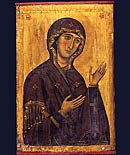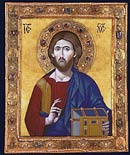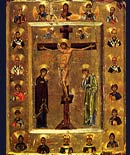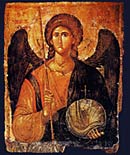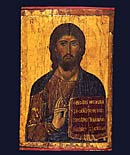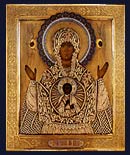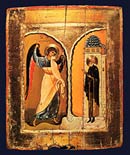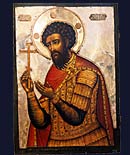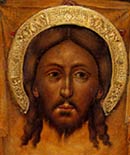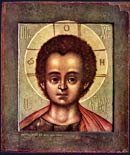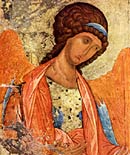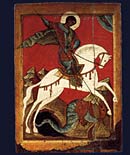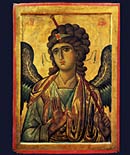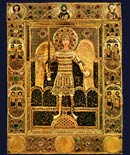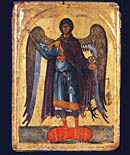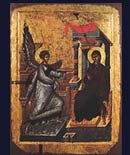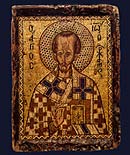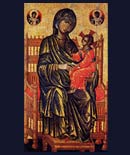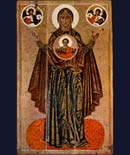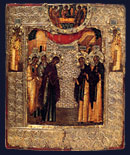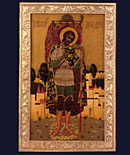Gallery - Our Lady of Vladimir
45 x 27 in 113.6 x 68 cm
Egg Tempera on Wood Panel
12th Century Byzantine
State Tretiyakov Gallery - Moscow
This ikon has suffered terribly through the years and its survival is miraculous. The ikon, which shows the Virgin pressing her Son to her cheek, is a style called "Mother of God of Tenderness" - Eleousa in Greek and Umilenie in Russian. Ikons showing intense human emotions were popular in Constantinople in the 12th century, when improving economic conditions led to a huge increase in ikons being produced for general public.
In the Virgin of Vladmir Christ looks intently at his Mother while her eyes are turned toward us, as if she were offfering her Child for the salvation of humankind. The face of the Virgin is painted in a extraordinary delicate technique. The colors are finely fused and it is impossible to detect individual brushstrokes. Originally the Virgin's robes were a stunning rich Azurite blue.
The ikon was painted in Constaninople and taken to Russia around 1120. In 1237 the cathedral where the ikon was housed was burnt by the Muslim Tatars. The ikon was badly damaged, but the faces and other areas survived. Later it was restored and heavily repainted. A new golden filigree ikon cover was created. The ikon was moved to the Uspenski Sobor in the Moscow Kremlin and became a symbol of the Russian State. During the War of 1812 the ikon was evacuated from Moscow and avoided the looting of Kremlin by Napoleon.
In December 1918, against the wishes of the Orthodox Church, Our Lady of Vladimir was forcibly removed from its jeweled shrine in Uspensky Sobor by the Bolsheviks and was shipped off to a restoration studio. Here the ikon was subjected to scientific analysis and was stripped of later layers of paint which revealed the original surviving Byzantine areas. This brutal transformation turned the ikon from an holy object into a pathetic shadow of its former self. It was then transferred to the Tretiyakov Gallery where the ikon was put on display in a sterile glass case rather like a medical exhibit.
Photo credit: Deutsche Fotothek, Dresden
Egg Tempera on Wood Panel
12th Century Byzantine
State Tretiyakov Gallery - Moscow
This ikon has suffered terribly through the years and its survival is miraculous. The ikon, which shows the Virgin pressing her Son to her cheek, is a style called "Mother of God of Tenderness" - Eleousa in Greek and Umilenie in Russian. Ikons showing intense human emotions were popular in Constantinople in the 12th century, when improving economic conditions led to a huge increase in ikons being produced for general public.
In the Virgin of Vladmir Christ looks intently at his Mother while her eyes are turned toward us, as if she were offfering her Child for the salvation of humankind. The face of the Virgin is painted in a extraordinary delicate technique. The colors are finely fused and it is impossible to detect individual brushstrokes. Originally the Virgin's robes were a stunning rich Azurite blue.
The ikon was painted in Constaninople and taken to Russia around 1120. In 1237 the cathedral where the ikon was housed was burnt by the Muslim Tatars. The ikon was badly damaged, but the faces and other areas survived. Later it was restored and heavily repainted. A new golden filigree ikon cover was created. The ikon was moved to the Uspenski Sobor in the Moscow Kremlin and became a symbol of the Russian State. During the War of 1812 the ikon was evacuated from Moscow and avoided the looting of Kremlin by Napoleon.
In December 1918, against the wishes of the Orthodox Church, Our Lady of Vladimir was forcibly removed from its jeweled shrine in Uspensky Sobor by the Bolsheviks and was shipped off to a restoration studio. Here the ikon was subjected to scientific analysis and was stripped of later layers of paint which revealed the original surviving Byzantine areas. This brutal transformation turned the ikon from an holy object into a pathetic shadow of its former self. It was then transferred to the Tretiyakov Gallery where the ikon was put on display in a sterile glass case rather like a medical exhibit.
Photo credit: Deutsche Fotothek, Dresden
< last: Christ Pantokrator from Sinai next: St. George and the Dragon >

